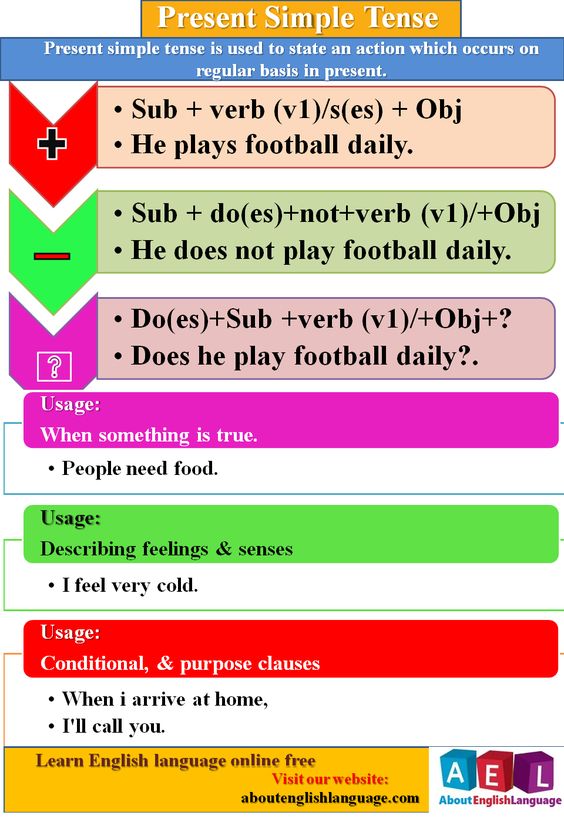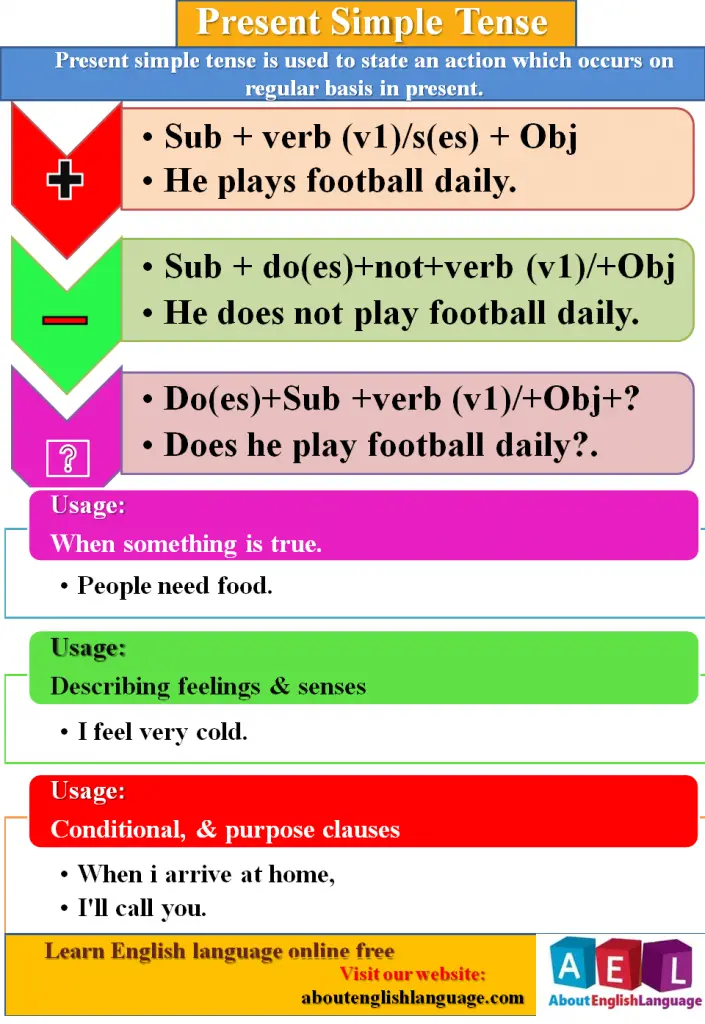The simple present tense is used for habits and routines, permanent situations, states, facts, etc. The simple present tense is also called the present Indefinite tense. In this lesson, you will learn about its uses, structure, definition, example sentences, and helping verbs.

Simple Present Tense Structure
Affirmative sentences: Sub + Verb+ object
Present indefinite tense exercise
| Sub | Verb | Object |
| I /We/You/They | play | football. |
| He/She/it | plays | football. |
Negative Sentences
| Sub | do not/ does not | verb | object |
| I/we/you/they | do not | play | football. |
| He/She/it | does not | play | football. |
Interrogative sentences
| Do/does | Sub | verb | object |
| Do | I/we/you/they | play | football? |
| Does | I/we/you/they | play | football? |
Uses of simple Present tense:
The simple present tense is used for general truth:
Example:
- It snows in winter
- Plants die without water.
- The sun rises in the east.
- Water boils at 100°C.
- Two and two make four.
Present Indefinite tense is used for the actions always happens.
Example:
- School starts at 9 am in the morning.
- Do you go to school by bus every day?
It is also used for operations of the present, which only last a moment or follow one another.
Example:
- The car stops.
- I park the car down the street and cross the street.
We use simple present tense for habits or things that we do regularly.
Example:
- Does she smoke?
- I get up early in the morning.
- Ahmed gets up at six o’clock every day.
- How often do you watch movies?
Important:
At the 3rd Person singular (he, she, it) s or es attached to the verb or an auxiliary verb.
In interrogative sentences or negative sentences, we use the construction with the auxiliary verb to do:
Example:
Do you work? No, I do not work.
Does she play? No she does not play.
More about simple Present uses:
Present Indefinite tense is used to describes the present form of a verb, but the action can also take place regularly or be repeated.
The simple present is formed with the infinitive, in the 3rd person singular (he, she, it or singular noun) the suffix -s or es is added with the first form of verb. There are, however, some exceptions to note. Which of these are you will find out in this article.
It is used to express actions happening in the present or if it takes place permanently, ie without specific time reference. Also regularly recurring and successive actions can be expressed with the simple present. For easier understanding, there are so-called keywords that tell you when to use the Present Indefinite tense (Simple Present). These keywords include:
- never
- every
- everyday
- often
- normally
- sometimes
- usually
- rarely
Difference: (Simple) Present Indefinite Tense and Present Progressive
In present Indefinite tense, we use the basic form of a verb, whereas in Present Progressive, for example, the form of the present is used as a modified form. If in Simple Present it’s simply “I walk“, then the present progressive says “I am walking“. The difference between the two tenses is that the Present Progressive is used the moment the action takes place. Other differences between Simple Present and Present Progressive can be found in the article.
More examples of using the (Simple) Present indefinite Tense
1. used for Repeated Action
“My train often arrives on time” (“My train often arrives punctually.”)
2. Statements without reference to time
“The day goes by.”
3. Fixed event that can take place in the future
The train leaves at 9 every morning.
4. Expiration of several actions
After school, I meet my friends,
Rules for (Simple)Present Indefinite tense
There are several rules on how verbs are used in the (Simple) Present Indefinite tense. Remember: The following pronoun does not change the verb:
I, you, we, they
For the pronouns he, she and it or any singular noun, s or es added to the verb in the (simple) present Indefinite. Remember, If the verb ends with the following letters: es is added
ch, o, s, sh, x, z
If the verb ends with a consonant plus y (eg study), the ” y ” is replaced by ” ies ” (marry> marries). For verbs with a vowel (auto-sounds: a, e, i, o, u) before the y, the y is not replaced.
The present perfect tense
Helping verb Do/Does used in conversation:
Asif: Do you study English?
Asim: Yes, I do.
Asif: Does Haris come to your house?
Asim:Yes, he comes sometimes.
Asif: Do other friends also come to you?
Asim: Yes, they do.
Asif: Do you stay in Mumbai?
Asim: No, I stay in Kolkata.
Simple present – Wikipedia
Present Simple tense Exercise:

Present Simple / Indefinite tense Exercise:
[streamquiz id=”1″]
